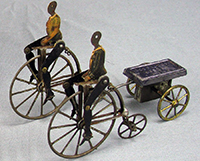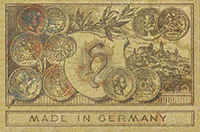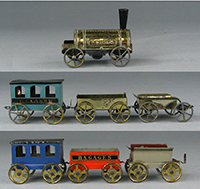 |
||||
|---|---|---|---|---|
| Hess boys on bicycles, circa 1880s L 5.8” (14.6 cm), W 3.3” (8.3 cm), H 4” (10.2 cm) Marked “Gebrauchs-Muster No. 7747” This pre-litho clockwork toy by Hess has also been observed with soldier graphics and flag. An unusual and scare example of this pre-litho toy which uses lithographed paper pasted to the piece. This piece is missing the head graphics of both boys. It came to me with provenance from the original boy owner, his death announcement, and its original box with his name inscribed inside. Lid of box is marked “Patent Rader” (patent wheel). Very fine spokes and rims are of stamped tinplate for large and small front wheels with cast metal axle bearings, cast metal rear wheels. Mostly soldered construction, boys mounted with tabs in slots. |
||||
| Hess Pre-litho construction variations, circa 1870s Vulkan pre-litho locomotive in top photo using cast metal wheels, but tab and slot construction. Middle photo shows wagons with cast metal wheels, tab and slot construction, female couplers extending beyond the body. Bottom photos shows wagons with stamped tinplate wheels, but utilizing soldered construction, with female couplers included in the body. Wagons use paper litho printing pasted to the tin. Most, but not all pieces, have the Hess logo stamped on the bottom. No locomotive was available to show with stamped tinplate wheels, but it is probably very similar to this cast wheel loco. These are probably transition pieces from one method of construction to another in a relatively short period of time in the company’s history. All of these pieces probably date from the mid to late 1870s. |
||||
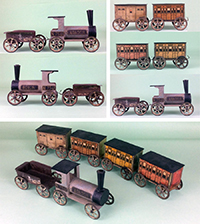 |
An early Hess pasted paper litho set. Before chromolithography (lithographic printing on tinplate) was perfected, Hess printed images on thin paper and pasted them to their trains. Hess produced several size paper litho sets but this set is the largest I have seen as it measures a full 33 inches (84 cm.) long when put together. The tender probably had paper litho pasted onto its sides, but it is long gone from this piece. The locomotive is marked "London" on one side, "Berlin" on the opposite side, and "No.7541" on both sides. It is 6" long (15.25 cm.), 5" high (12.7 cm.) and 2.75 " wide (7 cm.). Passenger and baggage cars are 5" long (12.7 cm.), 3.75 " high (9.5 cm.) and 2.75" wide (7cm.). All pieces also have the Hess logo embossed into the frame. | |||
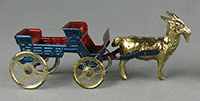 |
Pre-litho goat and wagon / candy container, circa 1880s L 5.375” (13.7 cm), W 1.5” (3.9 cm), H 1.75” (4.5 cm) Hess was known to make parts (especially wheels) or whole toys for other manufacturers. This goat with wagon was probably a candy container. All 4 wheels are marked with the Hess patent (44408) and solidly fastened to axles as was typically Hess. |
|||
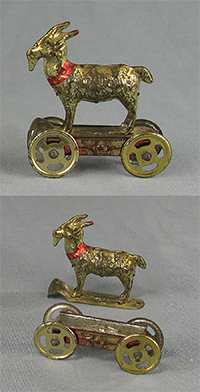 |
Pre-litho goat candy container on wheels, circa 1880s L 2.75” (7 cm), W .875” (2.2 cm), H 3.125” (8 cm) Another candy container with a slide open compartment. Curiously only one wheel is stamped with the Hess patent (44408). Wheels have cast axle bearings but use a nail like axle crimped on one end.
|
|||

